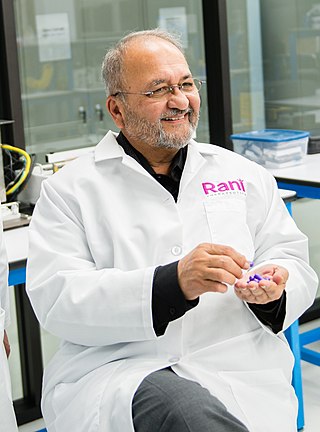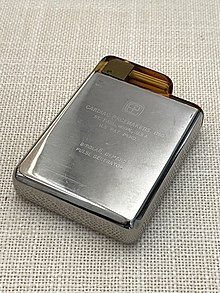
An artificial cardiac pacemaker, commonly referred to as simply a pacemaker, is an implanted medical device that generates electrical pulses delivered by electrodes to one or more of the chambers of the heart. Each pulse causes the targeted chamber(s) to contract and pump blood, thus regulating the function of the electrical conduction system of the heart.

Defibrillation is a treatment for life-threatening cardiac arrhythmias, specifically ventricular fibrillation (V-Fib) and non-perfusing ventricular tachycardia (V-Tach). A defibrillator delivers a dose of electric current to the heart. Although not fully understood, this process depolarizes a large amount of the heart muscle, ending the arrhythmia. Subsequently, the body's natural pacemaker in the sinoatrial node of the heart is able to re-establish normal sinus rhythm. A heart which is in asystole (flatline) cannot be restarted by a defibrillator; it would be treated only by cardiopulmonary resuscitation (CPR) and medication, and then by cardioversion or defibrillation if it converts into a shockable rhythm.

An implantable cardioverter-defibrillator (ICD) or automated implantable cardioverter defibrillator (AICD) is a device implantable inside the body, able to perform defibrillation, and depending on the type, cardioversion and pacing of the heart. The ICD is the first-line treatment and prophylactic therapy for patients at risk for sudden cardiac death due to ventricular fibrillation and ventricular tachycardia.
Wilson Greatbatch was an American engineer and pioneering inventor. He held more than 325 patents and was a member of the National Inventors Hall of Fame and a recipient of the Lemelson–MIT Prize and the National Medal of Technology and Innovation (1990).

Medtronic plc is an American-Irish medical device company. The company's operational and executive headquarters are in Minneapolis, Minnesota, and its legal headquarters are in Ireland due to its acquisition of Irish-based Covidien in 2015. While it primarily operates in the United States, it operates in more than 150 countries and employs over 90,000 people. It develops and manufactures healthcare technologies and therapies.
Guidant Corporation, part of Boston Scientific and Abbott Labs, designs and manufactures artificial cardiac pacemakers, implantable cardioverter-defibrillators, stents, and other cardiovascular medical products. Their company headquarters is located in Indianapolis, Indiana. Their main competitors are Medtronic, St. Jude Medical, and Johnson and Johnson.
Telectronics Pty Ltd was an Australian company best known for its role in developing the pacemaker. It was located in Lane Cove, Sydney. In 1988 the business was acquired by Pacific Dunlop. However, legal claims resulting from the sale of faulty pacemaker electrode leads inherited by the company in acquisition of Cordis Corporation of Miami led to eventual sale of the assets of the company and Pacific Dunlop restructuring itself into Ansell.
St. Jude Medical, Inc. was an American global medical device company headquartered in Little Canada, Minnesota, U.S., a suburb of Saint Paul. The company had more than 20 principal operations and manufacturing facilities worldwide with products sold in more than 100 countries. Its major markets include the United States, Europe, Latin America and Asia-Pacific. The company was named after Jude the Apostle, the patron saint of lost causes.
Barouh Vojtec Berkovits was one of the pioneers of bio-engineering, particularly the cardiac defibrillator and artificial cardiac pacemaker. In particular, Berkovits invented the "demand pacemaker" and the DC defibrillator.
Clinical cardiac electrophysiology, is a branch of the medical specialty of cardiology concerned with the study and treatment of rhythm disorders of the heart. Cardiologists with expertise in this area are usually referred to as electrophysiologists. Electrophysiologists are trained in the mechanism, function, and performance of the electrical activities of the heart. Electrophysiologists work closely with other cardiologists and cardiac surgeons to assist or guide therapy for heart rhythm disturbances (arrhythmias). They are trained to perform interventional and surgical procedures to treat cardiac arrhythmia.

Anthony J. Adducci was a pioneer of the medical device industry in Minnesota. He is best known for co-founding Cardiac Pacemakers, Inc., the company that manufactured the world's first lithium battery-powered artificial pacemaker. The lithium-iodide cell revolutionized the medical industry and is now the standard cell for pacemakers.

Transcutaneous pacing (TCP), also called external pacing, is a temporary means of pacing a patient's heart during a medical emergency. It should not be confused with defibrillation using a manual or automatic defibrillator, though some newer defibrillators can do both, and pads and an electrical stimulus to the heart are used in transcutaneous pacing and defibrillation. Transcutaneous pacing is accomplished by delivering pulses of electric current through the patient's chest, which stimulates the heart to contract.
Pacesetter Systems Inc. was a biotechnology company founded by Alfred E. Mann in 1965. The company manufactured various implantable medical devices invented by Robert Fischell and the rest of the team at the Johns Hopkins University Applied Physics Laboratory. Those inventions included the first commercial rechargeable implantable pacemaker, which was one of the first pacemakers to use radio waves for telemetry, and the implantable insulin pump. The insulin pump business was spun off into MiniMed in 1983 and then acquired by Medtronic in 2001. Pacesetter Systems Inc. was purchased by Siemens and then St. Jude Medical in 1994.

Mir A. Imran, is an Indian medical inventor, entrepreneur and venture capitalist. Imran has formed over 20 medical device companies since the early 1980s and holds over 400 patents. He is known for his role in developing the world's first implantable cardiac defibrillator.
Morton Maimon Mower was an American cardiologist specializing in electrophysiology and the co-inventor of the automatic implantable cardioverter defibrillator. He served in several professional capacities at Sinai Hospital and Cardiac Pacemakers Inc. In 1996, he became the chairman and chief executive officer of Mower Research Associates. He was inducted into the National Inventors Hall of Fame in 2002 for the development of the automatic implantable cardioverter defibrillator with Michel Mirowski in the 1970s. He continued his research in the biomechanical engineering laboratories at Johns Hopkins University.
Alois A. Langer is an American biomedical engineer best known as one of the co-inventors of the Implantable Cardioverter Defibrillator (ICD).

Cardiac resynchronisation therapy is the insertion of electrodes in the left and right ventricles of the heart, as well as on occasion the right atrium, to treat heart failure by coordinating the function of the left and right ventricles via a pacemaker, a small device inserted into the anterior chest wall.
Biotronik is a limited partnership multi-national cardiovascular biomedical research and technology company, headquartered in Berlin, Germany.
Cameron Health was a medical device developer based in San Clemente, California, USA. Cameron Health had its European office, Cameron Health BV, in Arnhem, The Netherlands. The privately held company's focus was on a new generation of minimally invasive implantable cardioverter-defibrillator (ICD) which they called a Subcutaneous Implantable Defibrillator (S-ICD). Cameron Health's approach avoided implanting transvenous leads into the heart, which had been the usual procedure for cardiac devices. Instead, the Cameron ICD was entirely implanted outside the thoracic wall.
Manny Villafaña, a child of Puerto Rican immigrants, he attended Cardinal Hayes High School in the Bronx. He began his medical career in 1964 at medical-device exporter Picker International. In 1967, he was hired away from Picker by Earl Bakken, CEO of Medtronic to become their first international sales administrator.











